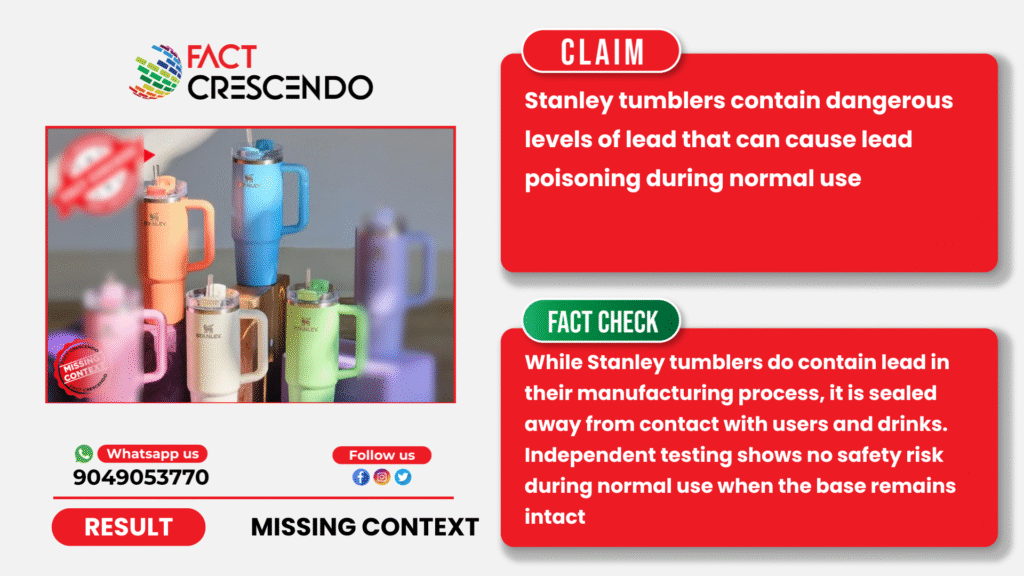
Stanley tumblers have seen significant growth in popularity through social media trends and marketing campaigns. Questions have emerged about their safety, particularly regarding lead content. In early 2024, social media discussions focused on the presence of lead in these tumblers, with various claims about potential health risks. This led to public discussion about the product’s safety and composition. Our fact check shows that while Stanley tumblers do contain a small amount of lead in their construction, independent testing indicates minimal risk during normal use.
Social Media Claim
Facebook users claim that Stanley cups pose a danger due to lead in their construction, suggesting they could cause lead poisoning.
These claim have been spreading virally, with many users expressing concern about using or gifting Stanley tumblers.
Fact Check
Yes, Stanley Tumblers Contain Lead, but It’s Sealed Away
It’s true that Stanley uses a small amount of lead in the vacuum insulation process. Specifically, a lead pellet is used to seal the space between the inner and outer stainless steel layers of the tumbler. This manufacturing technique has been widely used in the industry for years because lead has a low melting point and expands in a way that helps create a reliable thermal seal
However, the lead is not exposed to users. It is located at the bottom of the tumbler, far from the interior that holds the drink.
Unless the bottom cover is broken or removed, there is no risk of contact with the lead pellet.
Tests Show Minimal Safety Risk
Independent EPA-certified testing confirms that even under extreme conditions (e.g. acidic environments), lead levels leached from Stanley tumblers were well below California’s Proposition 65 safety limits. In practice, this means daily use does not expose users to hazardous levels of lead or cadmium.
Health experts, including those at Harvard and Nebraska Medicine, emphasize that consumers can continue using their Stanley cups safely, as long as the base remains intact.
However, if the base is damaged and the pellet becomes visible, users should stop using the cup immediately and contact the company for a replacement.
Independent testing by Consumer Reports and Lead Safe Mama LLC found lead in the sealing material under the bottom button of Stanley Quencher tumblers. Stanley confirms this but emphasizes that the lead is sealed away from any contact with users or drinks during normal use. However, if the bottom button comes off and exposes the lead material, stop using the tumbler immediately and contact Stanley for a free replacement under their lifetime warranty. To stay safe, follow the product’s cleaning instructions, either use a dishwasher if your model allows it, or hand-wash carefully to avoid damaging the sealed base.
DIY Lead Tests Are Not Reliable
While DIY lead test kits are readily available and seem like a convenient solution, research shows they aren’t very reliable. The U.S. Consumer Product Safety Commission (CPSC) has found that these kits often give incorrect results, either failing to detect lead when it’s present (false negatives) or indicating lead when there isn’t any (false positives). These kits have several limitations: they may not detect low levels of lead that could still be dangerous, they only test surfaces rather than deeper materials, and their results can be affected by other substances. Even EPA-recognized kits, while more accurate, are not foolproof and require precise usage to yield valid results.
Because of these shortcomings, health experts and government agencies strongly recommend professional laboratory testing as the only reliable method for detecting lead in consumer products (Source: Airsafe, PubMed).
Current Safety Record and Regulatory Status
As of June 2025, there have been no reported cases of lead poisoning linked to Stanley tumblers, and no recalls have been issued because of lead. The only legal challenges have been about whether Stanley properly informed customers about the presence of lead in their products, not about any actual harm to consumers. (Source)
Stanley’s Lead Statement
Stanley has confirmed they use a lead pellet in their manufacturing process to seal the vacuum insulation at the base of their products. According to the company, this is a standard industry practice that helps maintain temperature control. The lead is covered by a protective stainless steel layer that prevents any contact with users or drinks.
“Rest assured that no lead is present on the surface of any Stanley product that comes into contact with the consumer nor the contents of the product”
The company maintains that their products comply with all US safety standards, including California Proposition 65 and FDA requirements. They regularly test their products through independent labs to check for various substances including lead, BPA/BPS, PFOS, and phthalates. If a customer notices the base cap (which seals the lead pellet) has come off, Stanley recommends stopping use immediately and contacting them for a free replacement under their Lifetime Warranty. Looking ahead, the company is researching alternative materials to replace lead in their manufacturing process (Source).
Conclusion
While Stanley tumblers contain a small amount of lead in their manufacturing process, this lead remains sealed beneath a steel barrier with no risk to users during normal use. Laboratory tests, expert reviews, and regulatory findings are unanimous: lead exposure is virtually impossible unless the tumbler’s bottom is damaged or tampered with. The recent social media panic sparked by DIY testing has created unnecessary fears and confusion about product safety, despite no verified medical or regulatory cases of harm.
Source:
Harvard T.H. Chan School of Public Health

Title:Can a Stanley Tumbler Give You Lead Poisoning?
Fact Check By: Cielito WangResult: Missing Context


